
Exceptional customer support is the secret weapon for businesses. But what’s the hidden ingredient behind those stellar results? It’s an organization’s knowledge management (KM) system.
Knowledge is power, and that’s why savvy organizations are integrating the KCS framework with their workflows to wangle their knowledge bases. But scaling this knowledge beast can be tricky. And that’s where other challenges such as limited content findability, lack of knowledge creation, difficulty in capturing the voice of customer (VOC), mediocre self-service, and harnessing tacit knowledge emerge.
These roadblocks can hinder not just technology and processes, but also your people – both employees and customers.
Syntellis, a leading enterprise performance management provider, was sailing in the same boat. However, they didn’t just survive; they thrived by leveraging cutting-edge technology, especially Large Language Models (LLMs). Let’s dissect their journey and uncover the secrets to their success.
Roadblocks on the Path to Knowledge Management Success

1. Limited Incentives for Knowledge Creation
Who wants to spend hours crafting high-quality content if their efforts go unrecognized? Without proper incentives, knowledge capture and sharing take a backseat. This leads to outdated and irrelevant content within the knowledge base.
2. The Tacit Knowledge Trap
Imagine a complex customer query that stumps everyone. Unfortunately, the one agent who had the answer left the company without documenting their expertise. This scenario highlights the challenge of capturing and sharing tacit knowledge, a struggle Syntellis faced too. Traditional methods simply fall short.
3. Lack of VOC
Ever wonder why your team keeps fielding the same questions? It could be a gap between customer needs and the content you create. The knowledge that doesn’t reflect the VOC leads to missed opportunities for self-service, with support agents stuck in a loop of answering repetitive questions.
4. Limited Customer-facing Content
Are your customers struggling to find answers? If yes? Limited customer-facing content can be the potential reason.
Let me explain how – imagine someone bought a new phone and searched for the refund and return policy. Regrettably, these policies weren’t accessible to customers. It left them flying blind and forced to raise a support ticket.
This is what Syntellis faced when only 25% of their content was accessible to customers, hindering self-service and overwhelming support with basic inquiries.
5. Content Findability Woes
A library overflowing with unorganized books is a nightmare to navigate. That’s what it feels like for agents and customers when valuable knowledge lacks proper organization. Without clear tagging, categorization, and search functionality, finding the right information becomes a time-consuming quest.
6. Blind Spots in Identifying Content Gaps
Without a system to capture customer feedback and analyze usage data, Syntellis struggled to identify knowledge gaps. This made it difficult to prioritize content creation and ensure their knowledge base addressed customers’ most pressing needs.
Achieve Knowledge Management Success with the right solution!
Request a demo nowThe Winning Formula
Their solution? SearchUnify, a enterprise agentic platform, and Knowbler, its LLM-powered knowledge management solution. Knowbler, the world’s first knowledge-centered customer service software, streamlines knowledge creation, capture, and retrieval from diverse sources, making life easier for knowledge teams.
- Enhanced Content Findability
- Streamlined Knowledge Creation
- Improved Knowledge Sharing
The Successful Partnership of Syntellis and SearchUnify Yielded Impressive Results

[Upcoming Webinar] From Struggle to Success: Knowledge Management Made Easy With GenAI
Ready to unlock your knowledge management success? We can help!
Join our upcoming webinar, co-hosted by KM World, featuring industry experts Beth Coleman, Certified KCS®v6, Intelligent Swarming℠ Trainer and Founder of Catalynk, and Brian Corcoran, KCS Certified Practitioner & Cognitive Search Evangelist at SearchUnify to make your plan of action to boost agent productivity and customer satisfaction.














